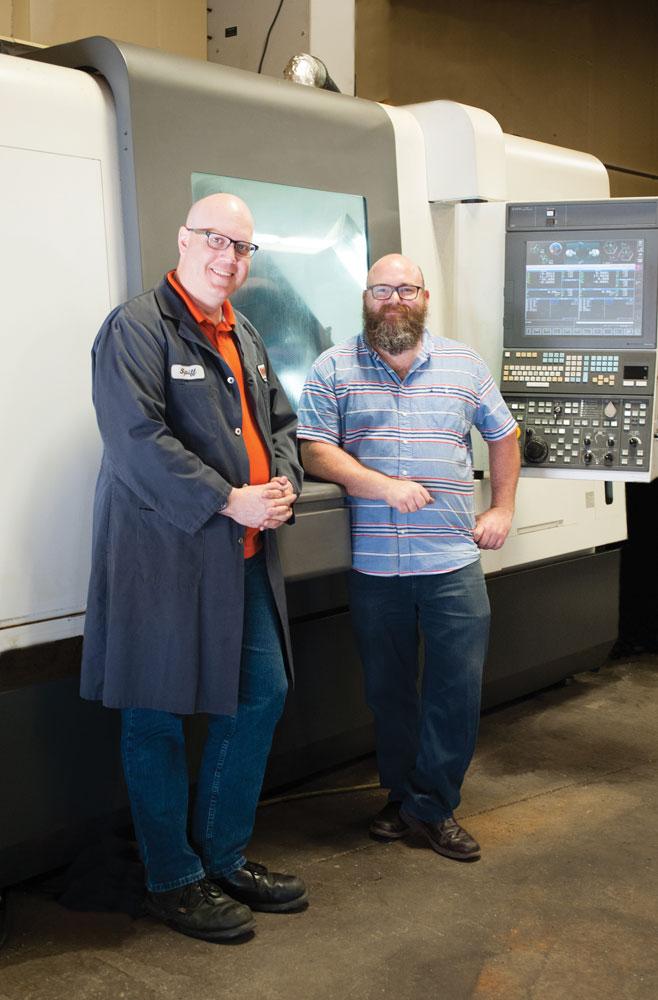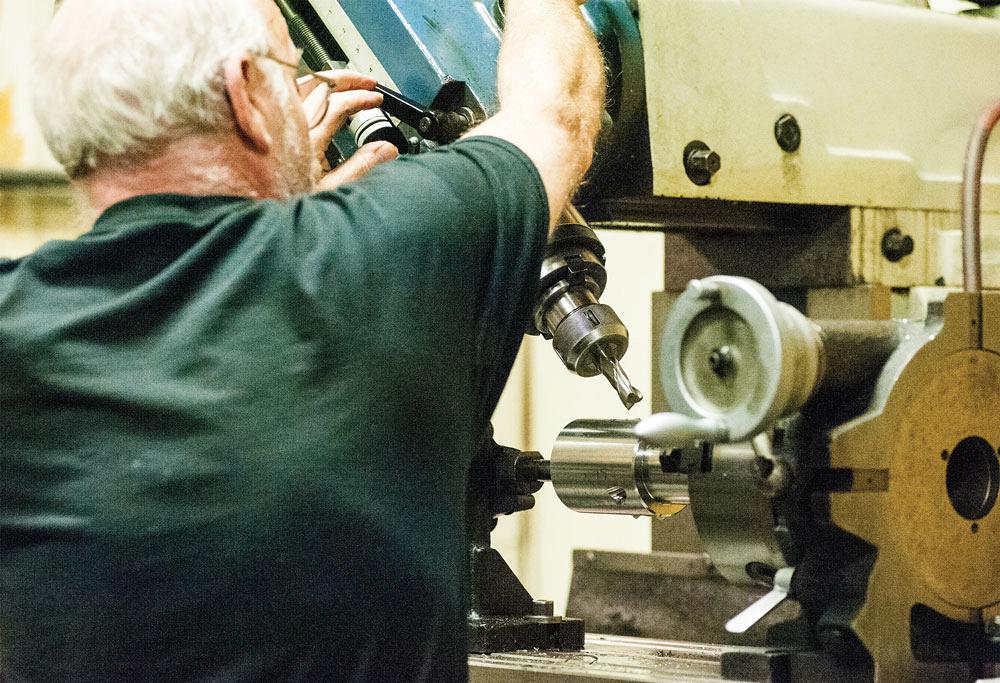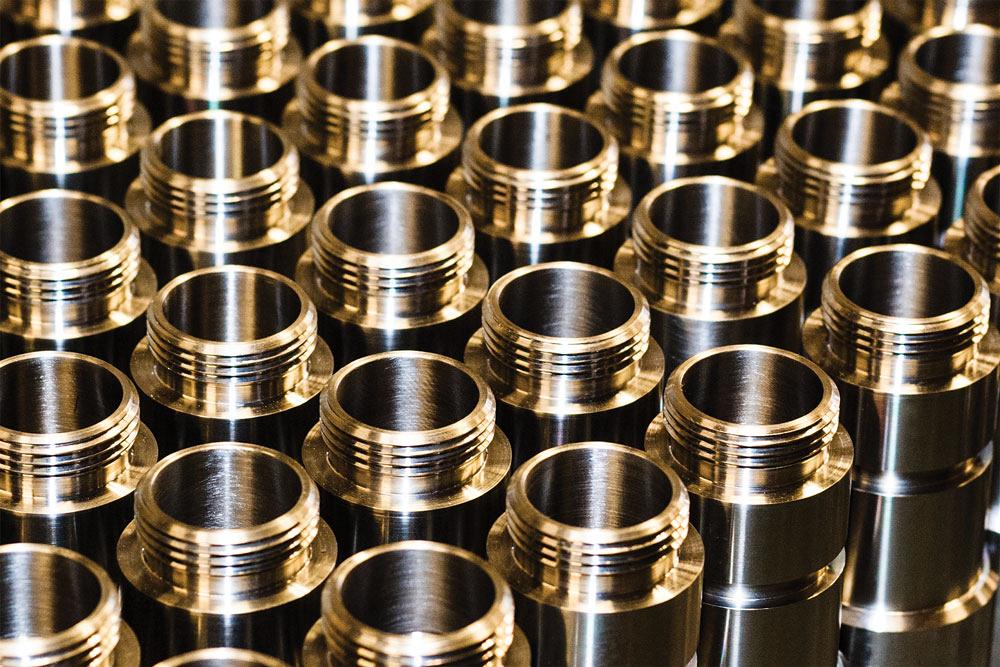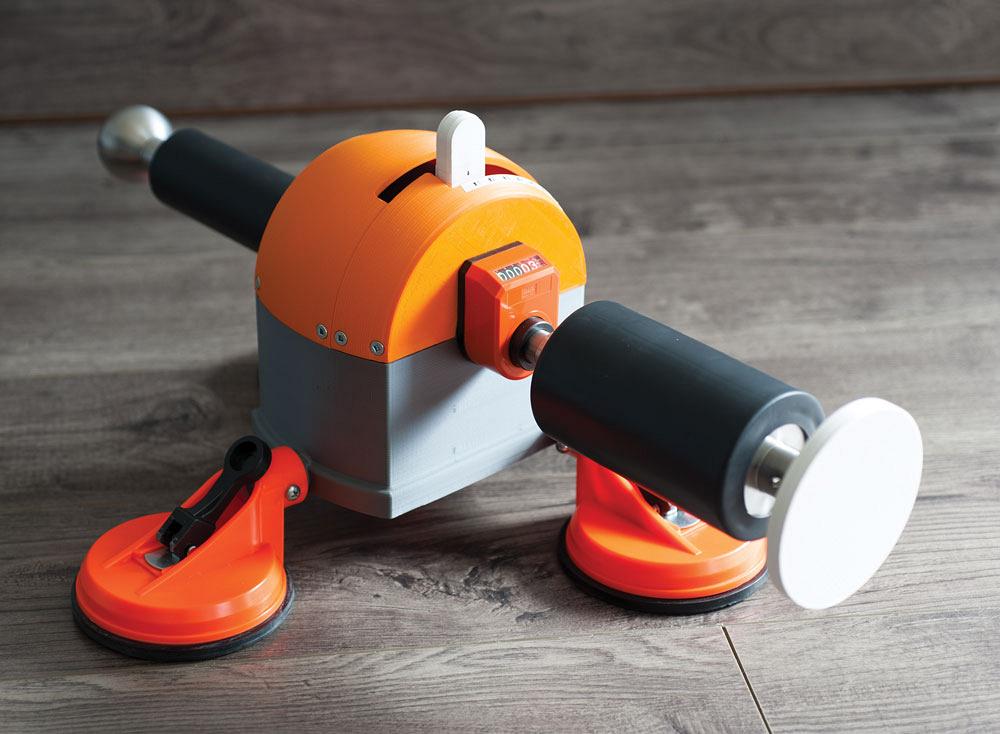- FMA
- The Fabricator
- FABTECH
- Canadian Metalworking
Karma Machining & Manufacturing: Between the idea and the marketing
Edmonton’s machinists, manufacturers, makers, and middlemen
- By Sue Roberts
- August 8, 2017
- Article
- Made In Canada

David deJong (left) and Darryl Short, principals of Karma Machining & Manufacturing in Edmonton, pose with their Nakamura-Tome 8-axis turn-mill centre.
They’re middlemen by design. David deJong, MSc, PEng, and Darryl Short, CT, CET, LBC, ditched their engineer and machinist jobs in 2010 to focus on a shared goal of bringing manufacturing back to North America. As fate—plus dedication, planning, and personal investment--would have it, they became the principals of Karma Machining & Manufacturing Ltd. in Edmonton, Alta., in 2011.
“David and I quit our jobs a year before we purchased the business. We had a conviction that it was going to work,” said Short. “He’s a professional engineer with a permit to provide engineering services, and I’m a certified machinist who can talk between the engineer and the machinists on the floor. Together we get things made.
“We’re quite selfish. Our whole goal is to bring manufacturing back to North America. Our vision is to have manufacturing in the area where it is needed. Within North America, transportation is relatively inexpensive. If we work together, we are capable of producing everything we need right here.”
Purchasing the job shop from a like-minded individual was a good beginning to forwarding their dream. “We purchased a company that was founded in 1998 with a machinist and a lathe,” deJong said. “The original owner connected with companies doing product development. He helped them with the manufacturing and established long-term relationships that we continue today.”
Their conviction to succeed has grown the shop from a handful of manual and CNC machines to a company with three distinct factories. The first is a commodity production CNC machine shop with vertical milling machines and several lathes. The second is a flexible manufacturing center (FMC) with a Nakamura-Tome 8-axis turn-mill centre, dual-spindle CNC lathes, and two surface grinders. The FMC currently is configured to make components for drilling tools but that can be reconfigured as required. The third factory is a rapid prototyping operation.
“It’s our flexible machining center and prototyping capabilities that help distinguish us. Our rapid prototyping includes many technologies, including additive, manual, and CNC machining, to help us help our customers quickly try out ideas and see what is going to work and what needs to be improved,” said deJong.
Producing new products at home
Assistance from the partners can begin long before the prototyping process. If an inventor is willing to share the background and production thought processes leading up to the design, deJong and Short can help determine the feasibility of an idea before heading into prototype production.
“We’re the middlemen in between the idea and marketing a final product,” said deJong. “The creative inventors come to us with an idea and quite often know how the product will be used, sold, distributed, but there is usually a huge gap in their knowledge of how things are made and what they will cost. We know how to make stuff.
“Say an inventor has come up with better Band Aid®. We don’t really know where the Band Aid is supposed to go, but he does. We don’t really know how it will be sold, but he does. He doesn’t know how it will be produced or how much that production will cost, but we do. So we’re always looking for customers who have those two sides of the equation in place.
“They are often eager to take their drawings to China or another manufacturing hub where things are made cheaper. Oftentimes that fails because overseas production can require that the customer purchase a container load of the item, which requires a lot of capital. A new item may not have been thoroughly tested out and need some adjustments after the initial batch has been in use, leaving a lot of product to be sold before incorporating the upgrade.”
When manufacturing locally, an inventor can invest $3,000 in a small batch of products rather than $30,000 in a container load. That batch can be sold and the money reinvested in the next run. The design can continue to be modified and improved as the smaller batches are produced and marketed with less of an up-front monetary commitment.
“We are trying to change the mentality--show that you don’t have to buy a complete container of overseas parts to get a good price. In several projects we have proven that we can compete on price. We can definitely work to deadlines by making things here. And quality is a given,” said deJong.
That same strategic, just-in-time thinking also applies to producing established products. For example, Short said, “We started to notice that forward planning of some customers isn’t always good, but recently some customers are looking for ways to reduce cash investments. I was asked to look at a customer’s inventory to see what they could stop buying from China. They shared their annual forecast and asked if we could help them reduce inventory and produce the product locally for the same price they paid offshore.
“Our answer was yes, we can, by purchasing materials for the product locally, eliminating the shipping costs, and producing on an as-needed basis. We give them a better product; keep the manufacturing here, which helps the community; and they save a lot of money each month because we can supply as needed.”
Choosing to collaborate
“The biggest challenge when dealing with manufacturing a new product is to build to cost, a concept that rarely seems to be emphasized,” deJong said. “We always start by asking our customers two questions because all of the decisions regarding how something is going to be made falls out of the answers. We ask, ‘How many do you want?’ and ‘What do you want to pay?’”
Karma takes a collaborative approach to its projects, working as a partner with customers and suppliers. Some customers find that approach difficult at first. “They may just want us to make the part and be hesitant to give us a lot of additional information. Once they figure out that by asking a lot of questions we are just trying to help them, they jump in with both feet and look for other ways we can contribute to their project,” said deJong.
Short said, “For example, if we know where a widget goes in an overall assembly,one of the value-adds we can provide is a design for manufacturing and assembly. We can help change a design so it can be made easier and cheaper and make it easier to assemble that can lead to more savings.”
Finding new markets
Alberta’s industry traditionally supports industrial customers. Oil and gas equipment suppliers have been at the top of the list. According to deJong, that may be shifting. “The turndown over the past 2-1/2 years has made it difficult for machine shops to survive. So we started pursuing jobs from other industries that might be viable. It turns out there is a lot to be done outside of the energy sector.”
One of those projects, which led to the company’s first proprietary product began with connections deJong and Short have with the University of Alberta and the Northern Alberta Institute of Technology.
“We were invited to work with students to design and manufacture a medical device to be used during physical therapy. It helps stroke patients relearn the use of their wrists and lower arms,” deJong said. “We did a significant portion of the design, manufactured a prototype, and the Glenrose Hospital used it in their clinic for a year. The product is called a FEPSim, named after the four motions of the wrist—flex, extension, pronation, and supination.

Lance Short, Darryl’s dad who has been in the trade since he was 15, uses his mold-making and tool-and-die experience to produce prototypes.
“Our initial thought was that we would build them one, they would be happy, end of the story. But it continues. The hospital thought there was a large enough market in Alberta for us to get interested in further developing and refining the device in preparation for a broader distribution,” said deJong. “Since then, we’ve come to an agreement with the Glenrose Hospital on the intellectual property to improve the product, applied for patents and a trademark, and connected with a distributor who is interested in marketing it across Canada and the U.S.
“This little opportunity from the educational connections that we have fostered and developed over the years has turned into something with the potential to completely transform our business and operations.”
Initially, additive manufacturing will be used to build about 80 per cent of the plastic parts for the device. “It’s a new product, so we can’t afford to invest $1 million in a tool and die or mold. So for the first two or three years we are going to rely on 3-D printing,” said deJong.
deJong sees this foray into medical device manufacturing as a potentially new focus for Alberta. “There is a lot of activity in the health and medical industry. A lot of start-ups, a lot of great ideas, but not a lot of manufacturing infrastructure to support those companies. Many manufacturers in Texas have been going through a similar change in focus since the energy sector has slowed. We’re not moving away from oil and gas because the demand for carbon energy is still there, but the cycle is extreme. Aerospace and automotive are much the same. The health care and medical industry is much steadier, so it makes sense to diversify and add it to the customer list.”
Sharing information
Both deJong and Short are dedicated to sharing information and collaboration. They are active members of several networking groups and associations. “We like to surround ourselves with people we can work with. Competitors with a collaborative spirit are always welcome,” Short said. “We believe in helping customers get exactly what they need. If they want us to turnkey a project, we’ll work with competitors, suppliers, and vendors to make sure we can do that for them.”
Short works to promote an attitude where manufacturers work together to assist each other and collectively advance their businesses. He experienced this type of cooperation first-hand during a recent trip to The Netherlands while developing the FEPSim.
“We have an established self-help club for manufacturers that might compete in some areas but not others to help each other. We’re looking at forming different groups to find ways to save us all time and money, and share resources,” he said.
“An interesting result of this collaboration is that one of our executive members is doing continuous improvement at local hospitals. He’s taken that manufacturing approach to a service industry, which is fantastic.”
Watching the uptick
deJong anticipates growing pains as the economy moves out of the recession. “We’re a little hesitant to feel that everything is back to normal, because we don’t know if the uptick of work for our production area and FMC is because inventory stocks are down and need to be brought up or if this increase will be somewhat stable,” he said.
“Historically, this is a slow time, and it’s not slow at the moment, but it’s hard to say where we will be in the next three months. But that’s the nature of a job shop, as well.”

Shop Foreman Matt Shea shows the benefits of conversational programming and its correlation to G-codes on a Haas RP (rapid prototyping) minimill.
Regarding the prototype side of the business, he said, “You never really know if someone walking in with a little drawing and an idea may be sitting on a goldmine. They may think they are and they’re not or they may be. We’re learning to distinguish between the two and building on that.”
AM is another tool in the arsenal
David deJong and Darryl Short presented “How 3-D Printing is Really Changing Machining” as part of the Society of Manufacturing Engineerings’ Knowledge Pod Series presented at the Western Manufacturing Technology Show in Edmonton. They shared their experiences and the stages of development for several parts for which 3-D printing worked well, discussed some innovative uses for 3-D printed components within their own facility, and talked about why traditional machining processes aren’t in danger.
“Additive manufacturing processes are interesting and versatile,” said deJong. “They allow us to produce shapes and features that can be very difficult or impossible to produce using conventional machining methods. “3-D printing allows us to design and produce some complex parts and have them to the customer the next day instead of machining for a week. The process can be a very quick or a very slow way of making something. It all depends on the part.”
For now, he added, for many parts machining is faster, more precise, and provides better surface finishes.
“We use 3-D printing where we can, but I don’t see it taking over our machining world very soon. It’s another tool in the arsenal to help meet customer needs and reduce costs.”
Photos by Dazaphoto.
Karma Machining & Manufacturing Ltd., 780-432-6611, www.karmamfg.ca
About the Author

Sue Roberts
2135 Point Blvd
Elgin, IL 60123
815-227-8241
Sue Roberts, associate editor, contributes to both Canadian Metalworking and Canadian Fabricating & Welding. A metalworking industry veteran, she has contributed to marketing communications efforts and written B2B articles for the metal forming and fabricating, agriculture, food, financial, and regional tourism industries.
Roberts is a Northern Illinois University journalism graduate.
subscribe now


Keep up to date with the latest news, events, and technology for all things metal from our pair of monthly magazines written specifically for Canadian manufacturers!
Start Your Free Subscription- Industry Events
MME Winnipeg
- April 30, 2024
- Winnipeg, ON Canada
CTMA Economic Uncertainty: Helping You Navigate Windsor Seminar
- April 30, 2024
- Windsor, ON Canada
CTMA Economic Uncertainty: Helping You Navigate Kitchener Seminar
- May 2, 2024
- Kitchener, ON Canada
Automate 2024
- May 6 - 9, 2024
- Chicago, IL
ANCA Open House
- May 7 - 8, 2024
- Wixom, MI






















